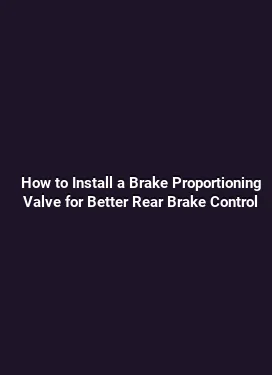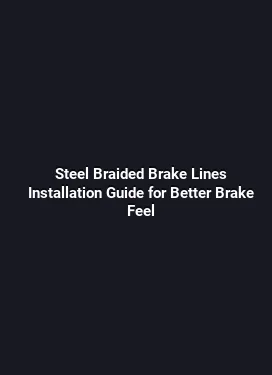Two-Piece vs One-Piece Brake Rotors: Weight and Cooling Benefits
Braking performance hinges on a delicate balance between component weight, thermal management, and drivetrain dynamics. When upgrading or tuning a braking system, enthusiasts and professionals alike consider rotor design as a pivotal factor. Two-piece and one-piece brake rotors each bring distinct advantages and trade-offs in terms of weight distribution, cooling efficiency, heat soak, and maintenance implications. This article delves into the core physics that drive rotor performance, examines practical scenarios where each design shines, and provides actionable guidance for selecting the right rotor configuration for street, high-performance, or competition use.
Understanding rotor architecture: what distinguishes two-piece from one-piece designs

At a high level, the primary distinction lies in how the rotor’s friction surface is mounted to the hub. A one-piece rotor, also known as a cast-iron or iron rotor with integral hub, combines the rotor disc and hat (the central mounting section) into a single forged or cast component. In contrast, a two-piece rotor separates the friction surface (the rotor disc) from the hat, connected by hardware such as bolts or a floating link. This separation enables independent management of rotor mass and hub interface, which has meaningful consequences for weight, heat conduction, and serviceability.
In practical terms, a two-piece rotor typically uses a replaceable friction surface connected to a lightweight alloy hat. The use of a lighter hat reduces overall rotor unsprung weight, which in turn influences suspension response, steering feel, and tire contact dynamics. The friction surface remains the primary region in contact with the brake pads and experiences the lion’s share of heat during deceleration. The hat, being closer to the hub, benefits from enhanced cooling connectivity through improved airflow and sometimes integrated cooling fins or channels in performance variants.
Weight implications: why rotor mass matters beyond mere numbers
Rotor weight is not a stand-alone metric; it interacts with the vehicle’s overall weight distribution, unsprung mass, and rotational inertia. Reducing rotor mass can improve suspension compliance, enable crisper tire feedback, and lower the energy required by the brake servo during repeated stops. However, a lighter rotor can also heat up more quickly under sustained braking if cooling is not optimized. Therefore, the design must consider both inertial relief and thermal resilience.
Two-piece rotors have a lower rotating mass compared to many traditional one-piece counterparts, thanks to the lighter hat assembly. This reduction translates into decreased rotational inertia, which can yield faster initial response to pedal input and reduced rolling resistance during cornering. The downside to mass reduction is the potential for higher peak blade temperatures if the cooling pathway is not sufficiently engineered. Some two-piece rotors mitigate this risk by incorporating ventilation schemes, larger vane counts, or optimized hat-to-disc clearances that promote heat transfer from the friction surface to the cooling air stream.
From a practical perspective, a well-designed two-piece rotor can deliver meaningful weight savings without sacrificing structural integrity or durability, especially in applications where rotor replacement frequency is high due to heat cycles. In endurance-oriented setups, the ability to service only the friction surface while retaining a sturdy hat can reduce maintenance time and total ownership cost over the rotor’s life cycle.
Cooling dynamics: how rotor design influences heat dissipation
Braking generates heat through friction, converting kinetic energy into thermal energy. Managing this heat is essential to prevent brake fade, maintain consistent pedal feel, and preserve pad and rotor life. Rotor cooling is achieved through a combination of surface area, airflow, vane geometry, and thermal conductivity between the friction surface and the cooling medium (air or brake fluid if using floating designs).
One-piece rotors often rely on inherent mass and surface geometry for dissipation. They can accommodate larger overall disc diameters and have fewer interfaces that can obstruct airflow. However, where two-piece designs excel is in tailoring the cooling path. The hat can feature open channels, lightweight alloys with high thermal conductivity, and vented vanes that channel air through and around the friction surface. The fan-like effect of rotor vanes can be tuned to promote air exchange during deceleration, reducing heat soak in high-demand driving conditions such as track days or spirited mountain drives.
When comparing cooling performance, the critical parameters include vane count and orientation, disc thickness, hat geometry, and contact between the disc and the hub. In many two-piece systems, the contact region between the friction surface and the hat is engineered to minimize heat transfer resistance. This optimization allows heat to move more readily from the disc into the hat and then into the surrounding airflow. The outcome is improved sustained braking performance, less pad fade, and a more linear response under repeated braking cycles.
Practical cooling considerations in real-world scenarios

For street use, a well-chosen rotor design prioritizes predictable brake behavior across a broad temperature range. Two-piece rotors with efficient cooling paths can help maintain consistent bite during long highway descents or hot summers, reducing the risk of brake fluid boil and pedal sponginess. In performance or race contexts, rotor designs may feature targeted cooling, such as larger ventilation channels or drift-compatible floating hats that promote airflow around the entire circumference of the disc.
Maintenance-oriented drivers should also consider rotor coatings, pad materials, and caliper compatibility. While two-piece rotors offer advantages in weight and cooling, they require precise torque specifications during installation to avoid rotor runout or hat-gap inconsistencies. Conversely, one-piece rotors can deliver robust durability with fewer interfaces to service, but at the cost of higher unsprung weight and potentially slower heat dissipation if the disc-to-hin couple is less optimized for airflow.
Material science and thermal performance: what to look for when evaluating rotors
Rotor materials and construction dictate how heat is absorbed, stored, and released. One-piece rotors are often forged or cast from gray iron with good thermal conductivity and wear resistance. Two-piece rotors leverage a friction surface made from the same or similar material, but the hat may be fashioned from lightweight steel or aluminum alloys that offer a favorable strength-to-weight ratio and enhanced heat tolerance. Aluminum hats, in particular, can reduce unsprung mass significantly, but they require careful clamping and floating mechanisms to prevent bondline deformation under high heat cycles.
Coatings and surface treatments on the friction surface, such as anti-wear and thermal barrier layers, contribute to longer pad life and reduced thermal hotspots. Ventilation patterns, including ray- or spider-like vane configurations, can be designed to maximize the cross-sectional area through which cooling air flows. In higher performance builds, engineers may incorporate cross-drilling or drilled/slotted patterns on the friction surface to augment cooling; however, such features can influence pad deposition and should be selected in harmony with pad compound choices and driving style.
Real-world applications: choosing the right rotor design for your vehicle and goals
Vehicles with aggressive driving characteristics, frequent hill climbs, or track duty cycles benefit from rotor designs that prioritize cooling and weight reduction. Two-piece rotors are particularly well-suited for cars that see repeated, high-temperature braking with modest maintenance intervals. They enable easier replacement of the friction surface, which can reduce downtime in race environments. In contrast, one-piece rotors may be advantageous for daily drivers or vehicles where simplicity, reliability, and low maintenance are prioritized. Their robust construction and fewer interfaces can translate to excellent longevity in normal operating conditions, provided heat management is adequate for the typical driving profile.
Vehicle dynamics also play a central role. Lower unsprung weight improves wheel hop control and tire grip during aggressive cornering. The lighter rotating mass of a two-piece rotor contributes to quicker steering response and potentially sharper pedal modulation. For heavier vehicles or those with high braking energy demands, pairing a two-piece rotor with high-performance pads, advanced cooling ducts, and optimized caliper mounting yields a cohesive system that maintains consistent friction characteristics across a broad thermal range.
Integration considerations: caliper compatibility, rotor thickness, and hub standards
When upgrading, verify the hub diameter and bolt pattern align with the rotor’s hat design. Two-piece rotors demand precise alignment to ensure uniform contact and avoid rotor runout. The thickness of the friction surface must be matched to the caliper piston size and pad backing plate to maintain proper pad sweep and knock-back clearance. Spacer rings or shims may be required in some installations to achieve the correct rotor offset and to preserve rotor runout tolerances within manufacturer specifications.
Additionally, consider brake fluid capacity and line routing. Higher heat generations may require upgraded fluid with higher boiling points and improved moisture resistance to prevent brake fade. The system’s overall cooling philosophy should extend beyond the rotor to include caliper design, ducting, and even the under-hood airflow management for optimal thermal stability during demanding driving events.
Trend-aware decisions: balancing performance, durability, and cost
In recent years, the automotive aftermarket has seen a broader adoption of advanced rotor materials, floating hat designs, and modular systems that enable rapid servicing without sacrificing performance. Enthusiasts often pursue a two-piece setup to gain weight savings and stronger thermal resilience, especially where frequent braking cycles are expected. The cost premium for two-piece rotors is typically offset by longer life in the friction surface and reduced downtime when maintenance is performed on the friction layer rather than the entire rotor assembly.
From a reliability standpoint, the best outcomes arise when rotor design is matched with driving style, vehicle weight, and intended use. A daily driver who commutes in urban traffic may not notice a pronounced benefit from a two-piece system, while a track enthusiast or a hot-lapping setup will likely perceive meaningful improvements in pedal feel consistency and fade resistance. The selection should also reflect availability of compatible replacement parts and service expertise in the local market, as installation precision is a key contributor to performance gains and longevity.
Maintenance and care: maximizing rotor life and performance
Regardless of configuration, proper brake maintenance begins with pad selection aligned to rotor type and driving demands. Bedding procedures allow the friction surface to establish a consistent transfer layer with the pad, promoting stable friction coefficients and reducing early wear. Regular inspection of rotor thickness, runout, and bolt integrity is essential, particularly for two-piece designs where hat-to-disc interfaces can be susceptible to loosening if torque specs are not observed.
Cleaning is another practical consideration. Avoid aggressive solvents near the brake assembly, and use recommended cleaners that remove dust and road debris without damaging the friction surface. For two-piece rotors, ensure that the mounting hardware remains clean and properly torqued; incorrect torque can lead to rotor warping or hat deformation under thermal cycles. If a rotor shows signs of excessive vibration, hot spots, or unusual noises, consult a professional shop to evaluate potential imbalance, pad deposition, or wear patterns that may indicate misalignment or system mismatch.
Conclusion: empowering informed choices for brake performance
Two-piece and one-piece brake rotors each offer distinct pathways to improving braking performance through weight management and cooling efficiency. The decision should be grounded in a clear understanding of driving goals, thermal demands, and maintenance willingness. For enthusiasts seeking enhanced responsiveness, reduced unsprung weight, and robust cooling in demanding driving conditions, a well-engineered two-piece rotor with an integrated cooling strategy can deliver noticeable benefits. Conversely, for applications where simplicity, durability, and cost efficiency are prioritized, a high-quality one-piece rotor remains a solid, reliable option. By evaluating material choices, cooling pathways, and installation tolerances, vehicle owners can craft a braking setup that aligns with their intended use and performance aspirations. Frequently Asked Questions






